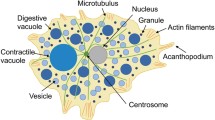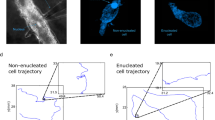Summary
The transverse velocity profiles of the anterograde flow of particles on the cell surface and around it are approximately parabolic. The peak velocity is recorded close to the membrane and the descendent arm of the profile is viscosity-dependent. It indicates that the extracellular forward flow is probably generated by a forward movement of the fluid fraction of the membrane itself. The retrograde component of extracellular movements is manifested by particles kept on the cell surface by adhesion, which behave exactly as the ectoplasmic layer on the opposite side of the membrane,i.e., they probably reflect the movement of that fraction of the surface material which is attached to the cortical microfilaments. In the longitudinal profile, the velocity of anterograde flow rises from the tail to the front of amoeba, but is generally related to the effective cell locomotion rate and not to the movements of any intracellular layer. Around the cells deprived of any attachment to the substratum, which cannot locomote but manifest vigorous intracellular movements, the anterograde flow ceases at least along 2/3 of their lenght. It persists, however, around the frontal fountain zone, where other particles still move backwards together with the retracted ectoplasmic layer. This indicates that the role of the forward flow of and on the cell surface is to compensate for: (1) the increase of the surface area in the frontal regions due to locomotion, (2) the withdrawal of a part of material which is hauled back by the retracting cortical layer. A comprehensive scheme of the velocity distribution within the different layers of a moving amoeba and around it has been constructed on the basis of present and earlier data.
Similar content being viewed by others
References
Allen RD, Roslansky JD (1959) The consistency of amoeba cytoplasm and its bearing on the mechanism of amoeboid movement. I. An analysis of endoplasmic velocity profiles of Chaos chaos (L.). J Biophys Biochem Cytol 6: 437–446
Bourguignon LYW, Bourguignon GJ (1984) Capping and the cytoskeleton. Int Rev Cytol 87: 195–224
Czarska L, Grębecki A (1966) Membrane folding and plasmamembrane ratio in the movement and shape transformation in Amoeba proteus. Acta Protozool 4: 201–239
De Petris S (1977) Distribution and mobility of plasma membrane components on lymphocytes. In: Dynamic aspects of cell surface organization, vol 3. North-Holland Publishing, New York, pp 643–728
—,Raff MC (1973) Fluidity of the plasma membrane and its implications for cell movement. In:Porter R, Fitzsimons DW (eds) Locomotion of tissue cells. Elsevier, Amsterdam London New York, pp 27–40
Grębecki A (1981) Effects of localized photic stimulation on amoeboid movement and their theoretical implications. Eur J Cell Biol 24: 163–175
-(1982) Supramolecular aspects of amoeboid movement. In: Progress in protozoology. Proc VI Internat Congr Protozool, part 1, pp 117–130
— (1984) Relative motion in Amoeba proteus in respect to the adhesion sites. I. Behaviour of monotactic forms and the mechanism of fountain phenomenon. Protoplasma 123: 116–124
— (1985) Relative motion in Amoeba proteus in respect to the adhesion sites. II. Ectoplasmic and surface movements in polytactic and heterotactic amoebae. Protoplasma 127: 31–45
— (1986) Two-directional pattern of movements on the cell surface of Amoeba proteus. J Cell Sci 83: 23–35
-(1988) Bidirectional transport of extracellular material by the cell surface of locomoting Saccamoeba limax. Arch Protistenk 135 (in press)
Griffin JL, Allen RD (1959) Movements of the cell membrane of some freshand salt-water amoebae. Biol Bull Mar Biol Lab Woods Hole 117: 394–395
Haberey M (1971) Bewegungsverhalten und Untergrundkontakt von Amoeba proteus. Mikroskopie 27: 226–234
—,Wohlfarth-Bottermann KE, Stockem W (1969) Pinocytose und Bewegung von Amöben. VI. Kinematographische Untersuchungen über das Bewegungsverhalten der Zelloberfläche von Amoeba proteus. Cytobiologie 1: 70–84
Harris AK (1973) Cell surface movements related to cell locomotion In:Porter R, Fitzsimons DW (eds) Locomotion of tissue cells. Elsevier, Amsterdam London New York, pp 3–20
Jennings HS (1904) Contributions to the study of the behavior of lower organisms. VI. The movements and reactions of Amoeba. Carnegie Inst Wash, Yb 16: 129–234
Mast SO (1926) Structure, movement, locomotion and stimulation in Amoeba. J Morph 41: 347–425
Singer SJ, Nicolson GL (1972) The fluid mosaic model of the structure of cell membranes. Science 175: 720–731
Stockem W (1966) Pinocytose und Bewegung von Amöben. I. Die Reaktion von Amoeba proteus auf verschiedene Markierungssubstanzen. Z Zellforsch Mikrosk Anat 74: 372–400
— (1972) Membrane turnover during locomotion of Amoeba proteus. Acta Protozool 11: 83–93
—,Wohlfarth-Bottermann KE, Haberey M (1969) Pinocytose und Bewegung von Amöben. V. Konturveränderungen und Faltungsgrad der Zelloberfläche von Amoeba proteus. Cytobiologie 1: 37–57
Wolpert L, Gingell D (1968) Cell surface membrane and amoeboid movement. Symp Soc Exp Biol 22: 169–198
Author information
Authors and Affiliations
Additional information
I dedicate this paper to Professor K. E. Wohlfarth-Bottermann with the best wishes for his 65th birthday.
Study supported by the Research Project CPBP 04.01 of the Polish Academy of Science.
Rights and permissions
About this article
Cite this article
Grębecki, A. Velocity distribution of the anterograde and retrograde transport of extracellular particles byAmoeba proteus . Protoplasma 141, 126–134 (1987). https://doi.org/10.1007/BF01272894
Received:
Accepted:
Issue Date:
DOI: https://doi.org/10.1007/BF01272894




